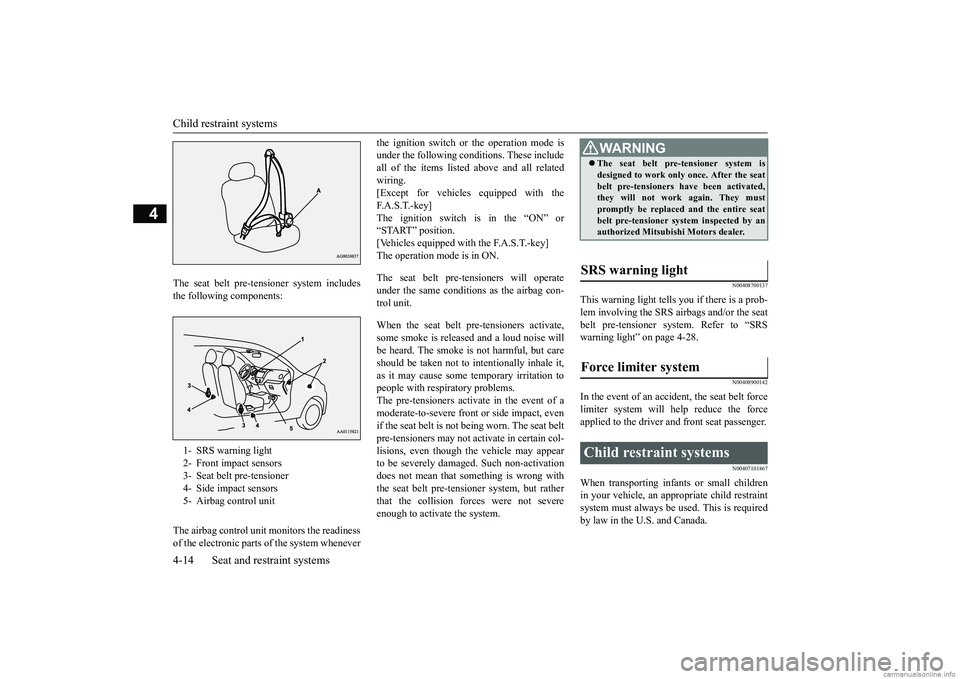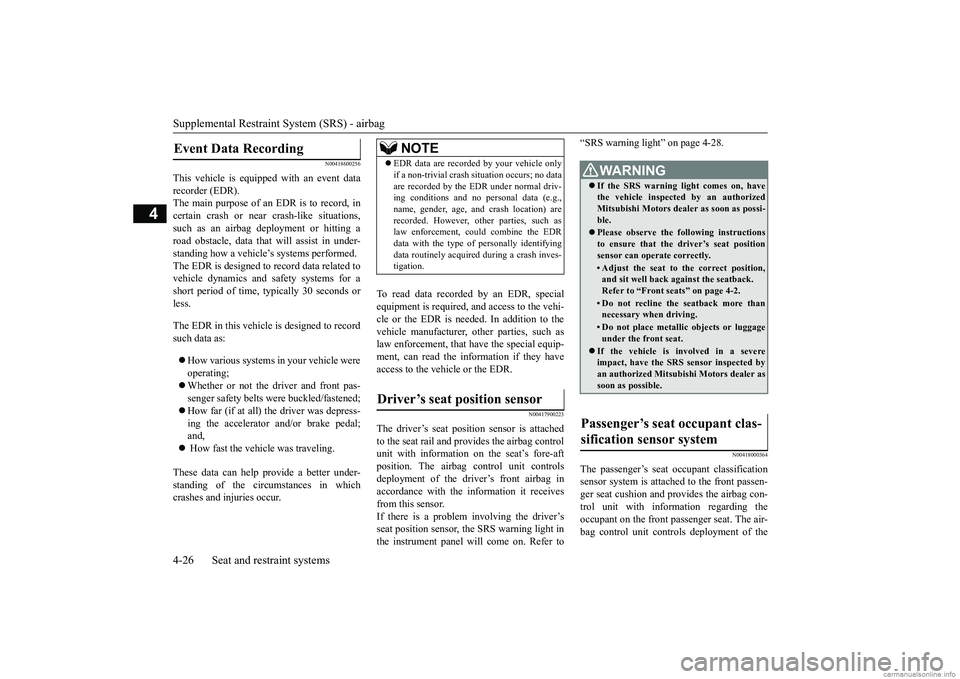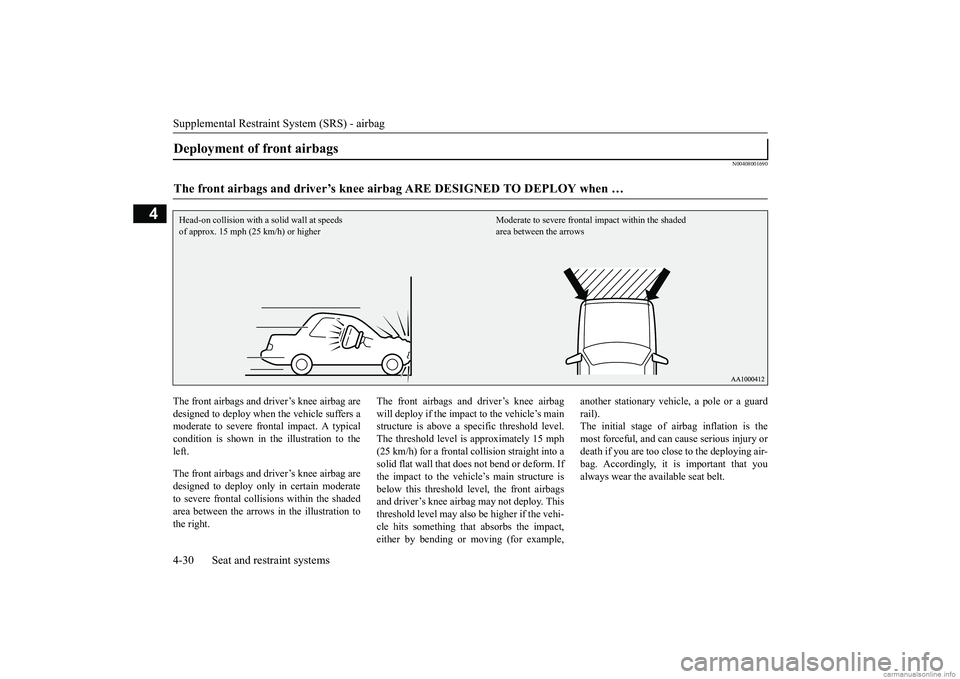air condition MITSUBISHI MIRAGE G4 2019 Owner's Manual (in English)
[x] Cancel search | Manufacturer: MITSUBISHI, Model Year: 2019, Model line: MIRAGE G4, Model: MITSUBISHI MIRAGE G4 2019Pages: 267, PDF Size: 38.31 MB
Page 6 of 267

Instruments and controls
Overview 1-2
1
Center vents P.7-2
Supplemental restraint system (SRS)-air- bag (for front passenger) P.4-22, 4-28
Heater (if so equipped) P.7-4 Manual air conditioning (if so equipped) P.7-7 Electric rear window defogger switch P.5-84 Automatic air conditioning (if so equipped) P.7-12
Side vents P.7-2
Glove compartment P.5-94
Engine hood release lever P. 9 - 4
Cup holder (for the front seat) P.5-94
12 V power outlets P.5-87
Electric rear window defogger switch P.5-84
Key slot (if so equipped) P.5-21
Gearshift lever (if so equipped) P.5-40 Selector lever (if so equipped) P.5-42
Fuel tank filler door release lever P. 3 - 3
Parking brake lever P.5-33
Cup holder (for the rear seat) P.5-94
DISPLAY AUDIO (if so equipped), Smartphone Link Display Audio (if so equipped), Clock (if so equipped)[Refer to the separate owner’s manual.]
USB input terminal P.5-85 Heated seats switches (if so equipped) P.4-4
Trunk lid release lever P.5-28
BK0267800US.book 2 ページ 2018年5月30日 水曜日 午後4時24分
Page 17 of 267

If this problem occurs... 2-6 Quick index
2
The engine does not start and the operation mode cannot be changed to OFF. (for vehicles equipped with the F.A.S.T.-key)
1. Move the selector le
ver to the “P” (PARK) position, a
nd then change the operation mode
to OFF. (For vehicles with CVT)2. One of the other causes c
ould be low battery voltage.
If this occurs, the keyless entr
y system and the F.A.S.T.-key
operation will also not oper-
ate.Contact an authorized Mitsubishi Motors dealer.
P. 5-14
The F.A.S.T.-key does not oper- ate.(for vehicles equipped with the F. A . S . T. - k e y )
Use the emergency key to lock and unlock the door. Insert the F.A.S.T.-key into the key slot of th
e floor console, and then start the engine or
change the operation mode.
P. 5-19, 5-20
Cannot shift the selector lever from the “P” (PARK) position. (for vehicles with continuously variable transmission (CVT))
Shift the selector lever while pressing the brake pedal. Check that the ignition switch
or the operation mode is in ON.
P. 5-42
The windows are fogged up.
Vehicles equipped with the he
ater without air conditioning
function or th
e manual air
conditioning
:
1. Set the mode selection dial
to the “ ” or “ ” position.
2. Turn on the blower. Vehicles equipped with th
e automatic air conditioning
:
Push the defogger switch
to change the “ ” mode.
P. 7-6, 7-10,
7-14
The engine does not start. The lights do not come on.The lights are dim. The horn does not honk. The horn sound is weak.
Have the battery checked. Rech
arge or replace as needed.
P. 8-2, 9-11
Problem
Do this
Ref. Page
BK0267800US.book 6 ページ 2018年5月30日 水曜日 午後4時24分
Page 22 of 267

Filling the fuel tank
General information 3-3
3
Use of gasolines blended with MMT may adversely affect performance, and cause themalfunction indicator on your instrument panel to come on. If this happens, contact an authorized Mitsubishi Motors dealer or arepair facility of your
choice for assistance.
Your vehicle may have
been designed to sat-
isfy California’s low-emission regulations based on clean-burning low-sulfur gasoline.Gasoline sold in parts of the country other than California is allowed to have a higher sulfur content. Using such gasoline couldadversely affect the ve
hicle’s catalytic con-
verter and cause the e
ngine malfunction indi-
cator (“SERVICE ENGINE SOON” or“Check engine light”) to come on. Illumina- tion of this indicator while using high-sulfur gasoline does not necessarily mean the vehi-cle’s emission-control system is malfunction- ing. Your authorized Mitsubishi Motors dealer may suggest usi
ng a different, lower-
sulfur brand of unleaded gasoline to deter- mine if the problem
is fuel-related.
N00301102005
Sulfur in gasoline
NOTE
Poor-quality gasoline
can cause problems
such as hard starting, stalling during idling,abnormal engine noise
, and poor accelera-
tion. If you experience any of these prob- lems, try using a differ
ent brand of gasoline.
If the engine malfunc
tion indicator (“SER-
VICE ENGINE SOON”
or “Check engine
light”) flashes, have
the vehicle inspected as
soon as possible by the nearest authorizedMitsubishi Motors dealer
or a repair facility
of your choice. Repeatedly driving short distances at low speeds can cause deposits to form in the fuel system and engine, resulting in hard startingand poor acceleration.
If these problems
occur, you are advised to add a detergent additive to the gasoline when you refuel thevehicle. The additive
will remove the depos-
its, thereby returning the engine to a normal condition. Be sure to use a MitsubishiMotors Genuine cleani
ng additive. Using an
unsuitable additive c
ould make an engine
malfunction. For details,
please contact the
nearest authorized Mits
ubishi Motors dealer.
Filling the fuel tank
WA R N I N GWhen handling fuel, comply with the safety regulations displayed by garages and filling stations.
Gasoline is highly flammable and explo- sive. You could be burned, seriouslyinjured or killed when handling it. Whenrefueling your vehicle,
always turn the
engine off and keep
away from flames,
sparks, and smoking materials. Alwayshandle fuel in well-ventilated outdoor areas. Before removing the fuel tank filler cap, be sure to get rid of your body’s static electricity by touching a metal part of thecar or fuel pump. Any
static electricity on
your body could create a spark that ignites fuel vapor. Perform the whole
refueling process
(opening the fuel tank filler door, remov-ing the fuel tank filler cap, etc.) by your- self; do not let any other person near the fuel tank filler. If you allowed a person tohelp you and that person was carrying static electricity,
fuel vapor could be
ignited. Do not move away from the fuel tank filler until refueling is fi
nished. If you moved
away and did something
else (for example,
sitting on a seat) part-way through the refueling process, you could pick up afresh charge of st
atic electricity.
Be careful not to inhale fuel vapor. Fuel contains toxic substances. Keep the doors and wi
ndows closed while
refueling the vehicle. If they were open, fuel vapor could get into the cabin.WA R N I N G
BK0267800US.book 3 ページ 2018年5月30日 水曜日 午後4時24分
Page 41 of 267

Child restraint systems 4-14 Seat and restraint systems
4
The seat belt pre-tens
ioner system includes
the following components: The airbag control unit monitors the readiness of the electronic parts of the system whenever
the ignition switch or the operation mode is under the following conditions. These includeall of the items listed
above and all related
wiring. [Except for vehicles
equipped with the
F.A.S.T.-key] The ignition switch is in the “ON” or “START” position.[Vehicles equipped with the F.A.S.T.-key] The operation mode is in ON. The seat belt pre-te
nsioners will operate
under the same conditions as the airbag con- trol unit. When the seat belt pr
e-tensioners activate,
some smoke is released and a loud noise willbe heard. The smoke is
not harmful, but care
should be taken not to
intentionally inhale it,
as it may cause some temporary irritation topeople with respiratory problems. The pre-tensioners activate in the event of a moderate-to-severe front or side impact, evenif the seat belt is not
being worn. The seat belt
pre-tensioners may not activate in certain col- lisions, even though the vehicle may appearto be severely damage
d. Such non-activation
does not mean that something is wrong with the seat belt pre-tens
ioner system, but rather
that the collision fo
rces were not severe
enough to activate the system.
N00408700137
This warning light tells you if there is a prob- lem involving the SRS airbags and/or the seat belt pre-tensioner sy
stem. Refer to “SRS
warning light” on page 4-28.
N00408900142
In the event of an accident, the seat belt forcelimiter system will help reduce the forceapplied to the driver and front seat passenger.
N00407101867
When transporting infants or small childrenin your vehicle, an appropriate child restraint system must always be
used. This is required
by law in the U.S. and Canada.
1- SRS warning light 2- Front impact sensors 3- Seat belt pre-tensioner 4- Side impact sensors 5- Airbag control unit
WA R N I N G The seat belt pre-tensioner system is designed to work only
once. After the seat
belt pre-tensioners have been activated,they will not work again. They must promptly be replaced and the entire seat belt pre-tensioner system inspected by anauthorized Mitsubis
hi Motors dealer.
SRS warning light Force limiter system Child restraint systems
BK0267800US.book 14 ページ 2018年5月30日 水曜日 午後4時24分
Page 52 of 267

Supplemental Restraint System (SRS) - airbag
Seat and restraint systems 4-25
4
N00407801587
The SRS includes the following components:
The airbag control unit
monitors the readiness
of the electronic parts of the system whenever the ignition switch or the operation mode is under the following conditions. These includeall of the item
s listed above a
nd all related
wiring. [Except for vehicles equipped with theF.A.S.T.-key] The ignition switch is in the “ON” or “START” position.[Vehicles equipped with the F.A.S.T.-key] The operation mode is in ON.
The airbags will operate under the same con- ditions as the airbag control unit. When the impact sensors detect a sufficient front or side impact to deploy the airbag(s), the appropriate airbag
(s) will be deployed.
When the airbag control unit detects rollover of the vehicle, curtain airbags will bedeployed. When airbags deploy, some smoke is released accompanied by a loud noise. The smoke is not harmful, but do not
intentionally inhale
the smoke as it may ca
use temporary irrita-
tion to people with respiratory problems. An inflated airbag will
deflate quickly, so you
may not even notice that the airbag was inflated. Airbag inflation does not prevent the driverfrom seeing or being able
to steer the vehicle,
and does not prevent people from leaving the vehicle.
WA R N I N G Older children should be seated in the rear seat with their seat belt properlyworn, and with an
appropriate booster
seat if needed. Refer to “Children
who have outgrown
child restraint syst
ems” on page 4-21.
How the Supplemental Restraint System works 1- Airbag module (Driver) 2- Passenger’s airb
ag off indicator
3- SRS warning light 4- Airbag module (Passenger)5- Side airbag modules 6- Driver’s seat position sensor
7- Passenger’s seat oc
cupant classifica-
tion sensor system
8- Airbag module (Driver’s knee)9- Airbag control unit 10- Front impact sensors 11- Side impact sensors12- Curtain airbag modules
CAUTION Airbags inflate very quickly and with great force. In certain situations, contact with an inflating airbag may cause small cuts, abra-sions, and bruises.
BK0267800US.book 25 ページ 2018年5月30日 水曜日 午後4時24分
Page 53 of 267

Supplemental Restraint System (SRS) - airbag 4-26 Seat and restraint systems
4
N00418600256
This vehicle is equipped with an event data recorder (EDR). The main purpose of an EDR is to record, incertain crash or near crash-like situations, such as an airbag deployment or hitting a road obstacle, data that
will assist in under-
standing how a vehicle’s systems performed. The EDR is designed to
record data related to
vehicle dynamics and sa
fety systems for a
short period of time,
typically 30 seconds or
less. The EDR in this vehicle is designed to record such data as: How various systems in your vehicle were operating; Whether or not the driver and front pas- senger safety belts
were buckled/fastened;
How far (if at all) the driver was depress- ing the accelerator and/or brake pedal;and, How fast the vehicle was traveling.
These data can help provide a better under- standing of the circumstances in whichcrashes and injuries occur.
To read data recorded
by an EDR, special
equipment is required, a
nd access to the vehi-
cle or the EDR is needed. In addition to the vehicle manufacturer, ot
her parties, such as
law enforcement, that have the special equip-ment, can read the information if they have access to the vehicle or the EDR.
N00417900223
The driver’s seat posit
ion sensor is attached
to the seat rail and provides the airbag control unit with information
on the seat’s fore-aft
position. The airbag control unit controls deployment of the driver’s front airbag in accordance with the information it receivesfrom this sensor. If there is a problem involving the driver’s seat position sensor, th
e SRS warning light in
the instrument panel will come on. Refer to
“SRS warning light” on page 4-28.
N00418000364
The passenger’s seat oc
cupant classification
sensor system is attached to the front passen- ger seat cushion and provides the airbag con- trol unit with inform
ation regarding the
occupant on the front passenger seat. The air- bag control unit controls deployment of the
Event Data Recording
NOTE
EDR data are recorded by your vehicle only if a non-trivial crash situation occurs; no dataare recorded by the EDR under normal driv-ing conditions and no
personal data (e.g.,
name, gender, age, and crash location) are recorded. However, other parties, such aslaw enforcement, could combine the EDR data with the type of personally identifying data routinely acquire
d during a crash inves-
tigation.
Driver’s seat position sensor
WA R N I N G If the SRS warning
light comes on, have
the vehicle inspecte
d by an authorized
Mitsubishi Motors dealer as soon as possi-ble. Please observe the following instructions to ensure that the driver’s seat position sensor can operate correctly.• Adjust the seat to the correct position,and sit well back
against the seatback.
Refer to “Front seats” on page 4-2.• Do not recline the seatback more thannecessary when driving.• Do not place metall
ic objects or luggage
under the front seat.
If the vehicle is involved in a severe impact, have the SRS sensor inspected byan authorized
Mitsubishi Motors dealer as
soon as possible.
Passenger’s seat occupant clas- sification sensor system
BK0267800US.book 26 ページ 2018年5月30日 水曜日 午後4時24分
Page 54 of 267

Supplemental Restraint System (SRS) - airbag
Seat and restraint systems 4-27
4
passenger’s front airbag in accordance with the information it receives from this system.The passenger’s front ai
rbag will not deploy
in an impact when the system senses no occu- pant on the front passenger seat or a child in achild restraint system. In this case, the pas- senger’s airbag off indicator will illuminate. Refer to “Passenger’s ai
rbag off indicator” on
page 4-27. If there is a problem involving the passen- ger’s seat occupant cl
assification sensor sys-
tem, the SRS warning light in the instrument panel will come on.Refer to “SRS warning light” page 4-28.
N00418101359
The passenger’s airbag off indicator islocated at shown in the illustration. The indicator normall
y comes on when the
ignition switch is turned to the “ON” position or the operation mode is put in ON, and goes out a few seconds later. In the following situ-ations, the indicator will stay on to show that the passenger front airb
ag is not operational.
The front passenger seat is not occupied.
WA R N I N GIf any of the following conditions occur, you should immediatel
y have your vehicle
inspected by an au
thorized Mitsubishi
Motors dealer as
soon as possible:
• The SRS warning light does not initially come on when the ignition switch or theoperation mode is under the following conditions.• [Except for vehicles equipped with theF. A . S . T. - k e y ] The ignition switch is in the “ON” or“START” position. [Vehicles equipped with the F.A.S.T.-key] The operation mode is in ON.• The SRS warning light does not go outafter several seconds.
• The SRS warning li
ght comes on while
you are driving.
To ensure that the passenger’s seat occu- pant classification sensor system can sense correctly, observe the following instruc-tions. Failure to follow these instructions can adversely affect
the performance of
the passenger’s airbag system.• Adjust the seat to the correct position,and sit well back
against the seatback.
Refer to “Front seats” on page 4-2.• Do not recline the seatback more thannecessary.• Never have more than one person (adultor child) sitting
on the seat.
• Do not place anything between the seat and the floor console.• When attaching a chil
d restraint system,
secure it firmly.• Do not place luggage
or other objects on
the seat.• Do not use a seat cover or a cushion.• Do not modify or replace the seat andseat belt.• Do not place luggage or other objectsunder the seat.• Do not place and use
an electronic device
such as a computer on the seat.• Do not place heavy objects on the seat orstick pins, needles, or other objects intoit.• Do not remove the seat cushion skin.WA R N I N G
• If any liquid is spilled on the seat, wipe itand dry the seat
immediately.
If the vehicle is involved in a severe impact, have the SRS sensors inspected by an authorized
Mitsubishi Motors dealer as
soon as possible.
Passenger’s airbag off indicator
WA R N I N G
BK0267800US.book 27 ページ 2018年5月30日 水曜日 午後4時24分
Page 55 of 267

Supplemental Restraint System (SRS) - airbag 4-28 Seat and restraint systems
4
The system senses that a child is using a child restraint system on the front passen-ger seat.
When the passenger’s seat occupant classifi- cation sensor system senses there is a person seated in the front pa
ssenger seat, the indica-
tor goes out to show that the passenger’s front airbag is operational.
N00408300579
There is a Supplemental Restraint System (SRS) warning light on
the instrument panel.
The system checks itself every time the igni- tion switch is turned
to the “ON” position or
the operation mode is put in ON. The SRSwarning light will co
me on for several sec-
onds and then go out. This is normal and means the system is working properly.
If there is a problem involving one or more of the SRS components, the warning light willcome on and stay on. The SRS warning light is shared by the SRS airbag and the seat belt
pre-tensioner system.
N00407900321
The driver’s airbag is located under the pad- ded cover in the middle of the steering wheel.
WA R N I N G If any of the follow
ing conditions occur,
you should immediat
ely have the airbag
system in your vehicle inspected by anauthorized Mitsubishi
Motors dealer as
soon as possible:• The passenger’s airbag off indicatorcomes on when an adul
t is sitting on the
front passenger seat.• The passenger’s airb
ag off indicator does
not come on when the front passengerseat is not occupied.• The passenger’s airb
ag off indicator does
not come on when the ignition switch is turned to the “ON” position or the oper- ation mode is put in ON.• The passenger’s airb
ag off indicator does
not come on when a child is in a childrestraint system on the front passenger seat.• The passenger’s airbag off indicatorcomes on and goes out repeatedly.
Do not attach any ac
cessory to your vehi-
cle that makes the passenger’s airbag offindicator difficult or impossible to see.You must be able to see the passenger’s airbag off indicator and verify the status of the passenger’s airbag system.
SRS warning light
WA R N I N G
WA R N I N G If any of the follow
ing conditions occur,
there may be a proble
m with the SRS air-
bags and/or seat belt pre-tensioners, and they may not function
properly in a colli-
sion or may suddenly
activate without a
collision:• Even when the ignition switch or theoperation mode is in
ON, the SRS warn-
ing light does not come on or it remainson.• The SRS warning li
ght comes on while
driving.The SRS airbags and seat belt pre-ten-sioners are designed to help reduce the risk of serious injury
or death in certain
collisions. If either
of the above conditions
occurs, immediately
have your vehicle
checked by an auth
orized Mitsubishi
Motors dealer.
Driver’s and passenger’s front airbag system
BK0267800US.book 28 ページ 2018年5月30日 水曜日 午後4時24分
Page 57 of 267

Supplemental Restraint System (SRS) - airbag 4-30 Seat and restraint systems
4
N00408001690
The front airbags and driver’s knee airbag are designed to deploy when the vehicle suffers a moderate to severe fr
ontal impact. A typical
condition is shown in the illustration to the left. The front airbags and driver’s knee airbag are designed to deploy only in certain moderateto severe frontal collisions within the shaded area between the arrows in the illustration to the right.
The front airbags and driver’s knee airbag will deploy if the impact to the vehicle’s main structure is above a sp
ecific threshold level.
The threshold level is approximately 15 mph (25 km/h) for a frontal co
llision straight into a
solid flat wall that does not bend or deform. Ifthe impact to the vehicle’s main structure is below this threshold level, the front airbags and driver’s knee airbag may not deploy. Thisthreshold level may also
be higher if the vehi-
cle hits something that absorbs the impact, either by bending or moving (for example,
another stationary vehi
cle, a pole or a guard
rail). The initial stage of airbag inflation is themost forceful, and can cause serious injury or death if you are too clos
e to the deploying air-
bag. Accordingly, it is important that youalways wear the available seat belt.
Deployment of front airbags The front airbags and driver’s knee airbag ARE DESIGNED TO DEPLOY when … Head-on collision with a solid wall at speeds of approx. 15 mph (25 km/h) or higher
Moderate to severe frontal
impact within the shaded
area between the arrows
BK0267800US.book 30 ページ 2018年5月30日 水曜日 午後4時24分
Page 75 of 267

Free-hand Advanced
Security Transmitter (F.A.S
.T.-key) (if so equipped)
5-10 Features and controls
5
The operations possible with the F.A.S.T.- key can be modified
as stated below.
(Keyless entry operations are possible.) For details, contact an authorizedMitsubishi Motors dealer. • Enabling only the locking and unlocking of the doors and the opening of the trunklid • Enabling only the starting of the engine • Deactivating the F.A.S.T.-key
WA R N I N G Individuals who use
implantable pace-
makers or implanta
ble cardiovascular-
defibrillators should
keep away from the
external and internal
transmitters. The
electromagnetic wa
ves used in the
F.A.S.T.-key may affe
ct the operation of
implantable pacemakers and implantable cardiovascular-
defibrillators.
A- External transmitter B- Internal transmitter
WA R N I N G Individuals using ot
her electro-medical
apparatus besides implantable pacemak-ers and implantable
cardiovascular-defi-
brillators should
check with the
manufacturer of the apparatus to confirm the effect of the el
ectromagnetic waves
used by the F.A.S.T.-key. The electromag- netic waves may affect
the operations of
the electro-medical apparatus.NOTE
The F.A.S.T.-key uses weak electromagnetic waves. In cases such as the following, operation may be imprope
r or unstable.
• The vehicle is near a facility that emits strong electroma
gnetic waves, such as a TV
transmitting tower, a pow
er station, a radio
station or an airport
• The key is carried together with other com- munication devices such
as cellular phones
or radios, or electrical appliances such ascomputers • The F.A.S.T.-key touches or is covered by a metal object • A keyless entry system is being used nearby • The battery of the F.A.S.T.-key is run down• The vehicle is in
a location with strong
electromagnetic
waves or noise
Use the emergency key in such circum- stances.Refer to “To operate
without using the
F.A.S.T.-key” on page 5-20. The F.A.S.T.-key is constantly performing reception operations
in its communication
with the vehicle. This means that the batteryis always running down, regardless of how often the F.A.S.T.-key is used. The battery life is about 1 to 2 years, depending on theusage conditions. Since the F.A.S.T.-key is constantly perform- ing reception operati
ons, the reception of
strong electrom
agnetic waves
can accelerate
the running down of the
battery. Do not place
near to electrical appliances such as televi- sions or computers.NOTE
BK0267800US.book 10 ページ 2018年5月30日 水曜日 午後4時24分